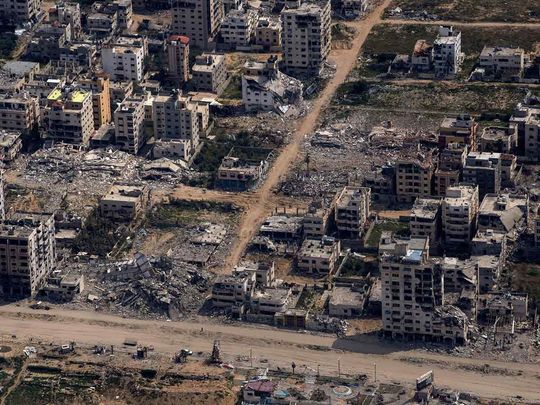
Writing about war in Gaza feels akin to walking barefoot on thorns. There are two groups, one believes in the narrative of victory and the other entrenched in the narrative of defeat. However, amid these entrenched positions, a global perspective on the Palestinian issue is emerging, along with broader outlines of a historical settlement.
Despite our desires or aspirations, influential global and regional powers seem to have reached a consensus that aims to transit the crisis from a chronic to solvable crisis, and from perpetual warfare to a path towards resolution. In this framework, the conflict in Gaza appears to mark the initial steps towards a resolution.
The contours of the solution entail adjustments from both the Palestinian and Israeli perspectives. Key elements include the establishment of a Palestinian state encompassing both the Gaza Strip and the West Bank, with negotiations overseen by the new Palestinian government and bolstered by robust international and regional support.
Moreover, the resolution necessitates the formation of a new Israeli government following early elections. These steps may require some time to materialise, following the implementation of a ceasefire, the release of Israeli prisoners in exchange for several Palestinian detainees in Israeli prisons.
Dynamic movement
These are the broad outlines agreed upon by a number of countries committed to fostering security and development in the region, averting the region prolonged conflicts and resource depletion. The Palestinians have paid dearly throughout this conflict. Despite sacrifices, the Oct. 7 operation has sparked a tremendous dynamic movement across the region and entire world, as well as in Israel.
Israel, too, has borne a heavy toll, deeply affecting Israeli society. The financial losses have been staggering, estimated at $6 billion thus far, exacerbating the societal divisions within Israel and prompting the departure of some segments of the population abroad.
Some view the details as endings, when in fact they are just details. For instance, they say there is a rift between Israel and the US, citing the US’s abstention from using its veto power in the recent UN Security Council resolution. However, this is likely a tactical manoeuvre rather than a definitive shift in US-Israel relations.
The current global conflict extends beyond the Palestinian issue, encompassing broader geopolitical tensions and challenges. While the situation in Palestine may represent wounds on the world stage, it does not pose an existential threat to the global order.
The conflict between the influential world powers, primarily the Western bloc and Russia, poses a significant threat, with its main battleground in Ukraine and its repercussions felt in other regions, including the Arab world.
Additionally, the West views groups it considers proxies of Iran, such as Hezbollah in Lebanon, the Houthis in Yemen, and Hamas in Palestine, as Iran’s military arms. So, “their exit from the scene” is an essential step before the grand agreement.
Indeed, Hamas leaders’ recent visit to Tehran aims to obstruct efforts towards reaching a comprehensive agreement and prevent its fruition. This stance also aligns with Israel’s desire for a “decisive victory,” where it does not have to concede to the establishment of a Palestinian state.
Hence, the paradox emerges: adversaries may find themselves aligned on shared objectives. Despite conflicting approaches to achieving these goals, the Israeli right anticipates a shift in the American administration, banking on robust support.
However, this calculation may not align with Israeli expectations, as a change in the American administration could prompt shifts in other geopolitical dynamics, notably concerning the Ukrainian conflict. Consequently, the prospect of an American reconciliation with Russia and potentially Iran could thwart Israel’s aspirations, particularly if public opinion in the US and the West turns against Israel’s actions.
On the other hand, Hamas is trying to spread unrest in the nearby arenas where it has supporters, such as Jordan to spread turmoil and push it into a “civil war”.
The conflicting parties seek to obstruct the transition of the crisis “from chronic to solvable,” disregarding the humanitarian costs involved. In contrast, the international and regional powers involved aim to reach compromise solutions that preserve the entire region from destruction and remove the issue from regional and global circulation.
What is lacking in the scene are statesmen who bring dossiers out of the back rooms into the open to salvage what remains of stability in the region. Otherwise, the region is on the path to chaos, the beginnings of which we may recognise, but its outcomes cannot be predicted, reminiscent of the chaos that ensued in our region after the First World War!
Mohammad Alrumaihi is an author and Professor of Political Sociology at Kuwait University





_resources1_16a31069e4e_small.jpg)







